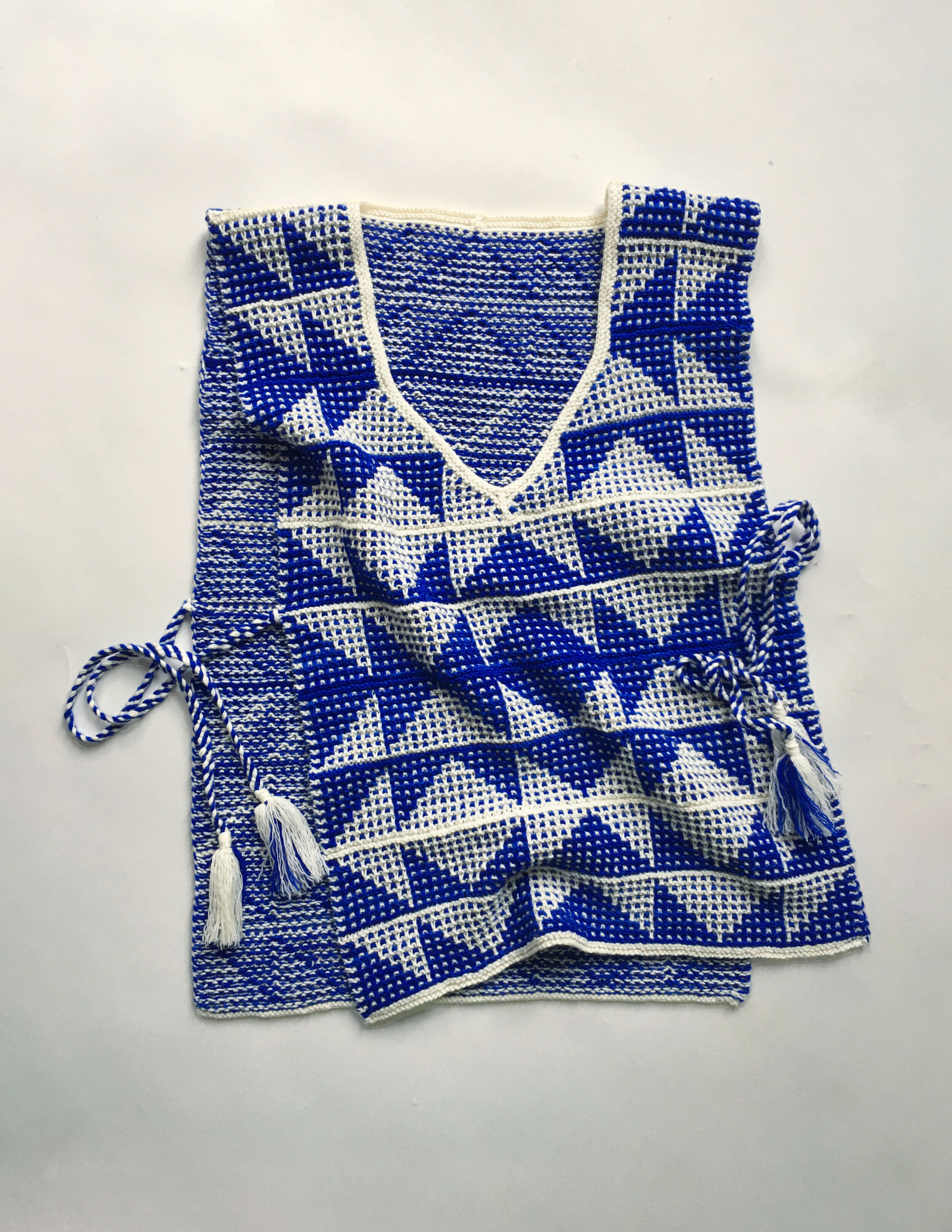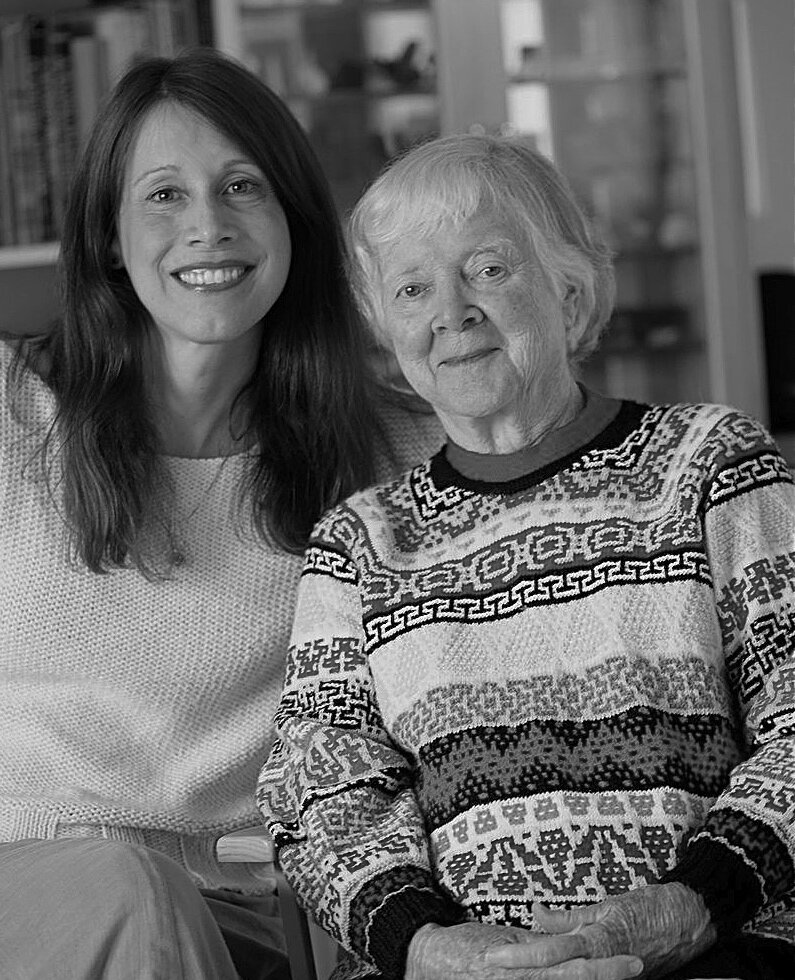MOSAIC VEST
In the second episode of Anthony Bourdain’s 2015 show Raw Craft, in an interview with tailor Frank Shattuck, there is a moment where Shattuck reverently talks about the rich history of master tailors, from those who lived centuries ago to those he apprenticed under for years and from whom he continues to learn.
It’s such a celebratory, feel-good show, especially for those who make things by hand. Bourdain’s recognition of the work involved, his curiosity and his kind eyes are all so enchanting. Whenever I’ve watched any of the 12 episodes of the series, they always prompt me to reflect upon our own traditions in knitting and the masters who have preceded us. They make me appreciate and think of innovative, curious women like Elizabeth Zimmerman and Barbara Walker and Deborah Newton and the enduring and vast contributions to knitting all of these women have made over many years.
For this project, I celebrated the rich (deceptively easy) colorwork technique Barbara Walker once developed and referred to as Mosaic Knitting. For those of us who don’t care much for the more tedious aspects of traditional colorwork (having to use and keep track of multiple, tangle-prone bobbins or be particularly mindful of maintaining consistent tension) Mosaic Knitting remains a dreamy, innovative alternative.
Implementing combinations of simple slipped and knit stitches, never handling more than one strand of yarn at a time, the technique is both tidy and freeing, so easy to do Walker once referred to it as a “beginner’s paradise.” Moreover, the intricacy of the designs one can achieve (considering the uncomplicated steps involved) is really quite thrilling.
For those unfamiliar with how the technique works, you begin by casting on and knitting two rows of a base color (say, white), and then on the following row introduce a second color (say, blue) and then, following a gridded chart, you simply slip each white stitch from the previous row (with the blue working yarn held in back) and knit every blue stitch. Then on the following row, still using the blue yarn, you just knit and slip the same stitches as the previous row. Alternating between blue and white on every right-side row, a fabric quickly emerges that is far easier to create than it looks.
Needless to say I’m a big fan of the technique and have used it for several projects over the years (at Purl Soho, I used it for the Speckled Scarf and Mosaic Blanket) and most recently for my Night Sky Hat.
I’ve had the honor of meeting and visiting Barbara Walker at her home in Florida several times over the years and specifically in the mosaic knitting realm, seeing and being able to discuss aspects of her creative process, to leaf through pages of her motifs (worn sheets of graph paper carefully marked with penciled squares) or watch as she unfolded and showed me one mosaic masterpiece after another (bedspreads and sweaters and swatches) and spoke of their design elements and construction.
The quiet, sort of old-school simplicity of sitting with some graph paper and a pencil also explains why I love this particular technique so much. In drawing grids, ideas can quickly come to life and in the case of this vest, developing the motif sprang from a beautiful image of bathroom tiles featured a while back in New York Magazine. The tiles had me thinking about triangles and the endless patterns one can create with them. I thought of mennonite quilting traditions and motifs (having grown up in the Finger Lakes region of New York State) and the gorgeous quilted works of art often on display and for sale at local festivals.
Wanting to highlight the neat edging created by mosaic knitting (which to me makes the fabric seem woven) I designed the vest to be entirely open on the sides. I made ties out of four-stranded braids and tassels, and chose the most vibrant blue yarn I could find.
Envisioning the piece as something easy and effortless, nodding back to travel and adventure and Bourdain, I think of the vest as something one might take on vacation to Greece to slip over your head just as the sun goes down over the Mediterranean (or in more practical terms, to have on hand at your favorite dive bar when the AC is cranked up just a bit too high).
My search for the perfect blue led to a new and treasured collaboration with Kelson Goods. The vibrancy of the blue Keith created for this project never gets old — I still stare at it after all of these months and feel my heart lift.
All of the motifs for the 21-page pattern are easily and efficiently presented in chart form only and include a detailed key on how to work and read them. I am also always available to answer any questions you may have along the way.
The beautiful places ideas can grow: from the New York Times Magazine, bathroom tile in Casa Cajueiro in Brazil created by Dutch designer Wilbert Das. Photo by Filipe Redondo.
If you don’t yet have this wonderful book in your library, it can be found through the link here at Schoolhouse Press.
A quiet mosaic moment in Barbara Walker’s home.
A few pages from one of Walker’s many albums, in which she models hundreds of her original designs.
A close-up of the mosaic stunner in the lower corner. Sarasota, Florida, 2019.
“We can only be said to be alive in those moments when our hearts are conscious of our treasures.” —Thornton Wilder
With Barbara in Florida in 2014.
MATERIALS YOU WILL NEED
Kelson Sport, 80% superwash merino, 20% nylon. Each skein is approximately 328 yards (300 meters). 2 (2, 3, 3, 4) skeins in Pool (Color A), approximately 500 (565, 700, 920, 1175) yards required. 2 (2, 2, 3, 4) skeins in Full Moon (Color B), approximately 435 (495, 615, 805, 1025) yards required.
A US 5 (3.75mm), 24-inch circular needle
Stitch markers, including several removable ones
Stitch holder or waste yarn
Crochet hook size E, F, or G (3.5, 3.75, or 4mm), for ties
GAUGE
26 stitches x 51 rows = 4 inches in Mosaic Pattern
24 stitches x 24 rows (12 Garter ridges) = 4 inches in Garter Stitch, using Color A
SIZES
1 (2, 3, 4, 5); to fit bust sizes 29-33 (33-37, 41-45, 49-53, 57-61) inches
Sample: The sweater pictured here is size 2.










